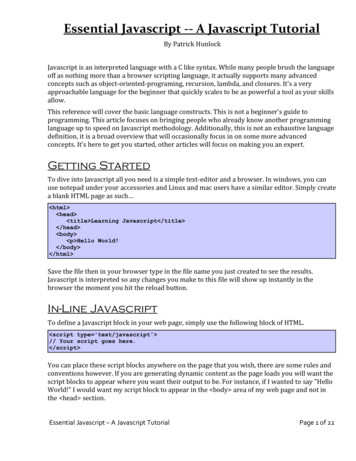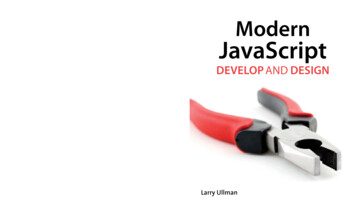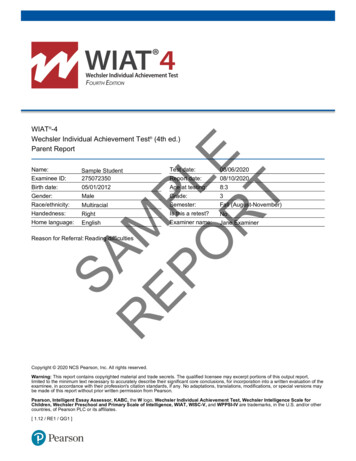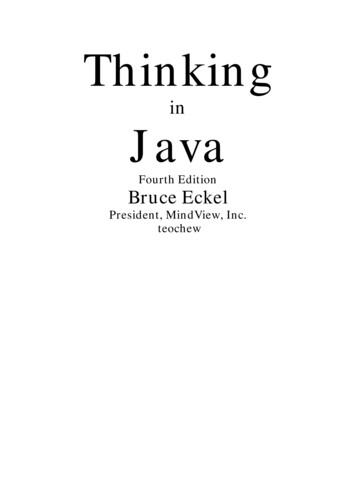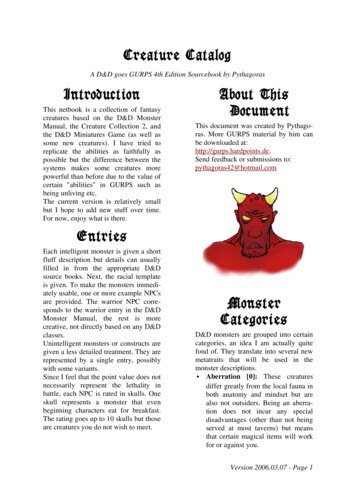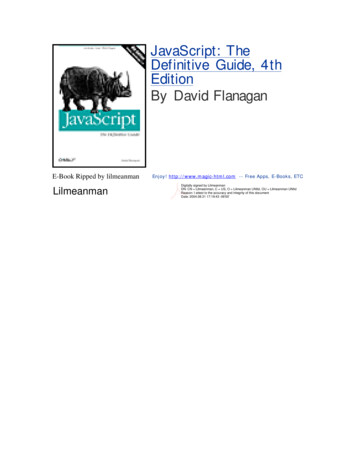
Transcription
JavaScript: TheDefinitive Guide, 4thEditionBy David FlanaganE-Book Ripped by lilmeanmanLilmeanmanEnjoy! http://www.magic-html.com -- Free Apps, E-Books, ETCDigitally signed by LilmeanmanDN: CN Lilmeanman, C US, O Lilmeanman UNltd, OU Lilmeanman UNltdReason: I attest to the accuracy and integrity of this documentDate: 2004.08.31 17:19:43 -06'00'
DedicationThis book is dedicated to all who teach peace andresist violence.
PrefaceThere have been many changes in the world of web programming with JavaScriptsince the third edition of this book was published, including: Second and third editions of the ECMA-262 standard have been published,updating the core JavaScript language. Conformant versions of Netscape'sJavaScript interpreter and Microsoft's JScript interpreter have been released.The source code for Netscape's JavaScript interpreters (one written in C and onewritten in Java ) has been released as open source and is available to anyonewho wants to embed a scripting language in his application.The World Wide Web Consortium (W3C) has published two versions (or levels)of a Document Object Model (DOM) standard. Recent browsers support thisstandard (to varying degrees) and allow client-side JavaScript to interact withdocument content to produce sophisticated Dynamic HTML (DHTML) effects.Support for other W3C standards, such as HTML 4, CSS1, and CSS2, has alsobecome widespread.The Mozilla organization, using source code originally contributed by Netscape,has produced a good fifth-generation browser. At the time of this writing, theMozilla browser is not yet at the 1.0 release level, but the browser is matureenough that Netscape has based its 6.0 and 6.1 browsers upon the Mozilla codebase.Microsoft's Internet Explorer has become the overwhelmingly dominant browseron desktop systems. However, the Netscape/Mozilla browser remains relevant toweb developers, especially because of its superior support for web standards. Inaddition, minor browsers such as Opera (http://www.opera.com) and Konquerer(http://www.konqueror.org) should be seen as equally relevant.Web browsers (and JavaScript interpreters) are no longer confined to the desktopbut have migrated to PDAs and even cell phones.In summary, the core JavaScript language has matured. It has been standardized and isused in a wider variety of environments than it was previously. The collapse ofNetscape's market share has allowed the universe of desktop web browsers to expand,and JavaScript-enabled web browsers have also become available on non-desktopplatforms. There has been a distinct, if not complete, move toward web standards. The(partial) implementation of the DOM standard in recent browsers gives web developers along-awaited vendor-independent API to which they can code.
What's New in the Fourth EditionThis edition of JavaScript: The Definitive Guide has been thoroughly updated in light ofthe changes I just described. Major new features include complete coverage of JavaScript1.5 and the third edition of the ECMA-262 standard on which it is based, and completecoverage of the Level 2 DOM standard.Throughout the book, the focus has shifted from documenting particular JavaScript andbrowser implementations ( JavaScript 1.2, Netscape 4, Internet Explorer 5, etc.) todocumenting the standards upon which those implementations are (or ought to be) based.Because of the proliferation of implementations, it is no longer practical for any one bookto attempt to document -- or for any one developer to attempt to understand -- everyfeature, proprietary extension, quirk, and bug of every implementation. Focusing on thespecifications instead of the implementations makes this book easier to use and, if youtake the same approach, will make your JavaScript code more portable and maintainable.You'll particularly notice the increased emphasis on standards in the new material on coreJavaScript and the DOM.Another major change in this edition is that the reference section has been split into threedistinct parts. First, the core JavaScript material has been separated from the client-sideJavaScript material (Part IV) and placed in a section of its own (Part III). This division isfor the convenience of JavaScript programmers who are working with the language in anenvironment other than a web browser and who are not interested in client-sideJavaScript.Second, the new material documenting the W3C DOM has been placed in a section of itsown (Part V), separate from the existing client-side JavaScript material. The DOMstandard defines an API that is quite distinct from the "legacy" API of traditional clientside JavaScript. Depending on the browser platforms they are targeting, developerstypically use one API or the other and usually do not need to switch back and forth.Keeping these two APIs distinct also preserves the organization of the existing client-sidereference material, which is convenient for readers of the third edition who upgrade tothis edition.In order to accommodate all the new material without making the book much, muchlarger, I've gotten rid of reference pages for the trivial properties of objects. Theseproperties are already described once on the reference page for the object, and puttinganother description in a reference page of its own was redundant and wasteful. Propertiesthat require substantial description, as well as all methods, still have reference pages oftheir own. Furthermore, the design wizards at O'Reilly have created a new interior designfor the book that remains easy and pleasant to read but takes up less space.Conventions Used in This BookI use the following formatting conventions in this book:
BoldIs occasionally used to refer to particular keys on a computer keyboard or toportions of a user interface, such as the Back button or the Options menu.ItalicIs used for emphasis and to signify the first use of a term. Italic is also used foremail addresses, web sites, FTP sites, file and directory names, and newsgroups.Finally, italic is used in this book for the names of Java classes, to help keep Javaclass names distinct from JavaScript names.Constant widthIs used in all JavaScript code and HTML text listings, and generally for anythingthat you would type literally when programming.Constant width italicIs used for the names of function arguments, and generally as a placeholder toindicate an item that should be replaced with an actual value in your program.Finding the Examples OnlineThe examples printed in this book are available for download from the book's web site.Follow the Examples link from the book's catalog wledgmentsBrendan Eich of the Mozilla organization is the originator and chief innovator ofJavaScript. I, and many JavaScript developers, owe Brendan a tremendous debt ofgratitude for developing JavaScript and for taking the time out of his crazy schedule toanswer our questions and even solicit our input. Besides patiently answering my manyquestions, Brendan also read and provided very helpful comments on the first and thirdeditions of this book.This book has been blessed with top-notch technical reviewers, whose comments havegone a long way toward making it a stronger, more accurate book. Waldemar Horwat at
Netscape reviewed the new material on JavaScript 1.5 in this fourth edition. The newmaterial on the W3C DOM was reviewed by Philippe Le Hegaret of the W3C; by PeterPaul Koch, Head of Client-Side Programming at the Dutch Internet consultancy andcreation company Netlinq Framfab (http://www.netlinqframfab.nl); by Dylan Schiemannof SitePen (http://www.sitepen.com); and by independent web developer Jeff Yates. Twoof these reviewers maintain useful web sites about web design with the DOM. PeterPaul's site is at http://www.xs4all.nl/ ppk/js/. Jeff's site is http://www.pbwizard.com.Although he was not a reviewer, Joseph Kesselman of IBM Research was very helpful inanswering my questions about the W3C DOM.The third edition of the book was reviewed by Brendan Eich, Waldemar Horwat, andVidur Apparao at Netscape; Herman Venter at Microsoft; and two independentJavaScript developers, Jay Hodges and Angelo Sirigos. Dan Shafer of CNET'sBuilder.Com did some preliminary work on the third edition. Although his material wasnot used in this edition, his ideas and general outline were quite helpful. Norris Boyd andScott Furman at Netscape also provided useful information for this edition, and VidurApparao of Netscape and Scott Issacs of Microsoft each took the time to talk to me aboutthe forthcoming Document Object Model standard. Finally, Dr. Tankred Hirschmannprovided challenging insights into the intricacies of JavaScript 1.2.The second edition benefited greatly from the help and comments of Nick Thompson andRichard Yaker of Netscape; Dr. Shon Katzenberger, Larry Sullivan, and Dave C.Mitchell at Microsoft; and Lynn Rollins of R&B Communications. The first edition wasreviewed by Neil Berkman of Bay Networks, and by Andrew Schulman and Terry Allenof O'Reilly & Associates.This book also gains strength from the diversity of editors it has had. Paula Ferguson isthe editor of this edition and of the third edition. She's given the book a thorough andmuch-needed going over, making it easier to read and easier to understand. FrankWillison edited the second edition, and Andrew Schulman edited the first.Finally, my thanks, as always and for so many reasons, to Christie.—David Flanagan, September 2001
Chapter 1. Introduction to JavaScriptJavaScript is a lightweight, interpreted programming language with object-orientedcapabilities. The general-purpose core of the language has been embedded in Netscape,Internet Explorer, and other web browsers and embellished for web programming withthe addition of objects that represent the web browser window and its contents. Thisclient-side version of JavaScript allows executable content to be included in web pages -it means that a web page need no longer be static HTML, but can include programs thatinteract with the user, control the browser, and dynamically create HTML content.Syntactically, the core JavaScript language resembles C, C , and Java, withprogramming constructs such as the if statement, the while loop, and the && operator.The similarity ends with this syntactic resemblance, however. JavaScript is an untypedlanguage, which means that variables do not need to have a type specified. Objects inJavaScript are more like Perl's associative arrays than they are like structures in C orobjects in C or Java. The object-oriented inheritance mechanism of JavaScript is likethose of the little-known languages Self and NewtonScript; it is quite different frominheritance in C and Java. Like Perl, JavaScript is an interpreted language, and itdraws inspiration from Perl in a number of places, such as its regular expression andarray-handling features.This chapter provides a quick overview of JavaScript; it explains what JavaScript can andcannot do and exposes some myths about the language. It distinguishes the coreJavaScript language from embedded and extended versions of the language, such as theclient-side JavaScript that is embedded in web browsers and the server-side JavaScriptthat is embedded in Netscape's web servers. (This book documents core and client-sideJavaScript.) This chapter also demonstrates real-world web programming with someclient-side JavaScript examples.1.1 JavaScript MythsJavaScript is the subject of a fair bit of misinformation and confusion. Before proceedingany further with our exploration of JavaScript, it is important that we debunk somecommon and persistent myths about the language.1.1.1 JavaScript Is Not JavaOne of the most common misconceptions about JavaScript is that it is a simplifiedversion of Java, the programming language from Sun Microsystems. Other than anincomplete syntactic resemblance and the fact that both Java and JavaScript can provideexecutable content in web browsers, the two languages are entirely unrelated. Thesimilarity of names is purely a marketing ploy (the language was originally calledLiveScript; its name was changed to JavaScript at the last minute).
JavaScript and Java do, however, make a good team. The two languages have differentsets of capabilities. JavaScript can control browser behavior and content but cannot drawgraphics or perform networking. Java has no control over the browser as a whole but cando graphics, networking, and multithreading. Client-side JavaScript can interact with andcontrol Java applets embedded in a web page, and, in this sense, JavaScript really canscript Java (see Chapter 22 for details).1.1.2 JavaScript Is Not SimpleJavaScript is touted as a scripting language instead of a programming language, theimplication being that scripting languages are simpler, that they are programminglanguages for non-programmers. Indeed, JavaScript appears at first glance to be a fairlysimple language, perhaps of the same complexity as BASIC. JavaScript does have anumber of features designed to make it more forgiving and easier to use for new andunsophisticated programmers. Non-programmers can use JavaScript for limited,cookbook-style programming tasks.Beneath its thin veneer of simplicity, however, JavaScript is a full-featured programminglanguage, as complex as any and more complex than some. Programmers who attempt touse JavaScript for nontrivial tasks often find the process frustrating if they do not have asolid understanding of the language. This book documents JavaScript comprehensively,so you can develop a sophisticated understanding of the language.1.2 Versions of JavaScriptJavaScript has evolved over the years, and Netscape has released several versions of thelanguage. Microsoft has released similar versions of the JavaScript language under thename "JScript." And ECMA (http://www.ecma.ch) has published three versions of theECMA-262 standard that standardize the JavaScript language under the awkward name"ECMAScript."Table 1-1 lists these various versions and explains their key features and how they arerelated to one another. In this book, I often use the name "JavaScript" to refer to anyimplementation of the language, including Microsoft's JScript. When I'm specificallyreferring to ECMAScript, I often use the terms "ECMA-262" or "ECMA."Table 1-1. Versions of JavaScriptVersionDescriptionJavaScript The original version of the language. It was buggy and is now essentially1.0obsolete. Implemented by Netscape 2.JavaScript Introduced a true Array object; most serious bugs resolved. Implemented by1.1Netscape 3.
Table 1-1. Versions of JavaScriptVersionDescriptionIntroduced the switch statement, regular expressions, and a number of otherJavaScriptfeatures. Almost compliant with ECMA v1, but has some incompatibilities.1.2Implemented by Netscape 4.JavaScript Fixed incompatibilities of JavaScript 1.2. Compliant with ECMA v1.1.3Implemented by Netscape 4.5.JavaScriptImplemented only in Netscape server products.1.4JavaScript Introduced exception handling. Compliant with ECMA v3. Implemented by1.5Mozilla and Netscape 6.JScript 1.0Roughly equivalent to JavaScript 1.0. Implemented by early releases of IE3.JScript 2.0 Roughly equivalent to JavaScript 1.1. Implemented by later releases of IE 3.JScript 3.0Roughly equivalent to JavaScript 1.3. Compliant with ECMA v1.Implemented by IE 4.JScript 4.0 Not implemented by any web browser.JScript 5.0Supported exception handling. Partially compliant with ECMA v3.Implemented by IE 5.Roughly equivalent to JavaScript 1.5. Fully compliant with ECMA v3.Implemented by IE 5.5 and IE 6. (IE 6 actually implements JScript 5.6, butJScript 5.55.6 is not different from 5.5 in any way that is relevant to client-sideJavaScript programmers.)ECMA v1The first standard version of the language. Standardized the basic features ofJavaScript 1.1 and added a few new features. Did not standardize theswitch statement or regular expression support. Conformantimplementations are JavaScript 1.3 and JScript 3.0.ECMA v2A maintenance release of the standard that included clarifications butdefined no new features.ECMA v3Standardized the switch statement, regular expressions, and exceptionhandling. Conformant implementations are JavaScript 1.5 and JScript 5.5.1.3 Client-Side JavaScriptWhen a JavaScript interpreter is embedded in a web browser, the result is client-sideJavaScript. This is by far the most common variant of JavaScript; when most people refer
to JavaScript, they usually mean client-side JavaScript. This book documents client-sideJavaScript, along with the core JavaScript language that client-side JavaScriptincorporates.We'll discuss client-side JavaScript and its capabilities in much more detail later in thischapter. In brief, though, client-side JavaScript combines the scripting ability of aJavaScript interpreter with the document object model (DOM) defined by a web browser.These two distinct technologies combine in a synergistic way, so the result is greater thanthe sum of its parts: client-side JavaScript enables executable content to be distributedover the Web and is at the heart of a new generation of Dynamic HTML (DHTML)documents.Just as the ECMA-262 specification defined a standard version of the core JavaScriptlanguage, the World Wide Web Consortium (W3C) has published a DOM specification(or recommendation) that standardizes the features a browser must support in its DOM.We'll learn much more about this standard in Chapter 17, Chapter 18, and Chapter 19.Although the W3C DOM standard is not yet as well supported as it could be, it issupported well enough that web developers can start writing JavaScript code that relieson it.Table 1-2 shows the core language version and DOM capabilities supported by variousbrowser versions from Netscape and Microsoft. Note that the versions of InternetExplorer listed in the table refer to the Windows version of that browser. The capabilitiesof Macintosh versions of IE often vary (sometimes significantly) from the samenumbered versions for Windows. Also, bear in mind that IE allows the JScript interpreterto be upgraded independently of the browser itself, so it is possible to encounter aninstallation of IE that supports a version of the language greater than that shown here.Table 1-2. Client-side JavaScript features by browserBrowserLanguageDOM capabilitiesNetscape 2JavaScript1.0Form manipulationNetscape 3JavaScript1.1Image rolloversNetscape 4JavaScript1.2DHTML with LayersNetscape 4.5JavaScript1.3DHTML with LayersNetscape 6 /MozillaJavaScript1.5Substantial support for W3C DOM standard; support forLayers discontinuedIE 3JScriptForm manipulation
Table 1-2. Client-side JavaScript features by browserBrowserLanguageDOM capabilities1.0/2.0IE 4JScript 3.0Image rollovers; DHTML with document.all[]IE 5JScript 5.0DHTML with document.all[]IE 5.5JScript 5.5Partial support for W3C DOM standardIE 6JScript 5.5Partial support for W3C DOM standard; lacks supportfor W3C DOM event modelThe differences and incompatibilities between Netscape's and Microsoft's client-sideversions of JavaScript are much greater than the differences between their respectiveimplementations of the core language. However, both browsers do agree upon a largesubset of client-side JavaScript features. For lack of better names, versions of client-sideJavaScript are sometimes referred to by the version of the core language on which theyare based. Thus, in client-side contexts the term "JavaScript 1.2" refers to the version ofclient-side JavaScript supported by Netscape 4 and Internet Explorer 4. When I use corelanguage version numbers to refer to client-side versions of JavaScript, I am referring tothe compatible subset of features supported by both Netscape and Internet Explorer.When I discuss client-side features specific to one browser or the other, I refer to thebrowser by name and version number.Note that Netscape and Internet Explorer are not the only browsers that support clientside J
client-side JavaScript that is embedded in web browsers and the server-side JavaScript that is embedded in Netscape's web servers. (This book documents core and client-side JavaScript.) This chapter also demonstrates real-world web programming with some clien
